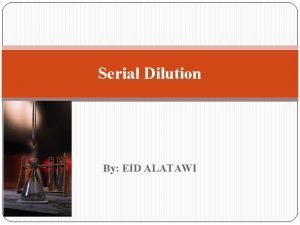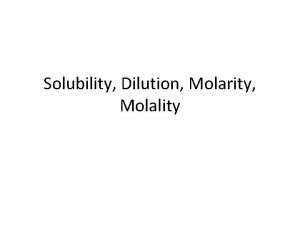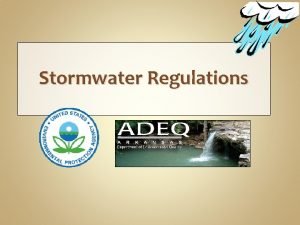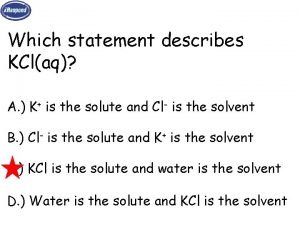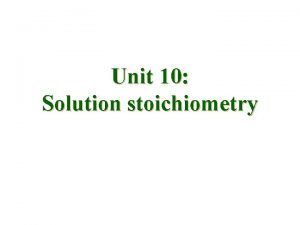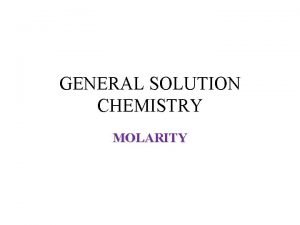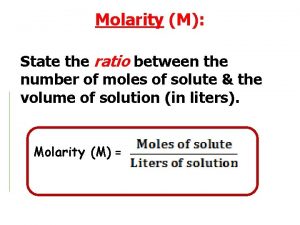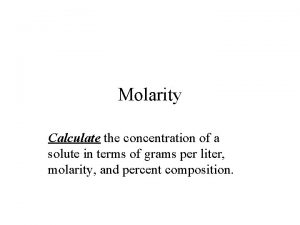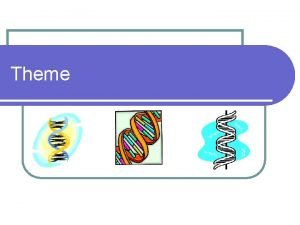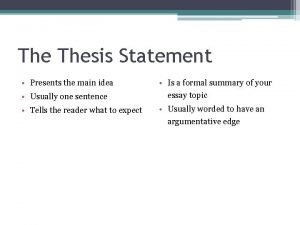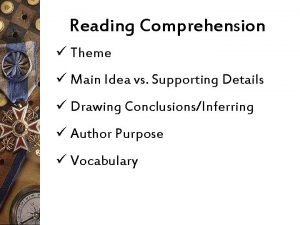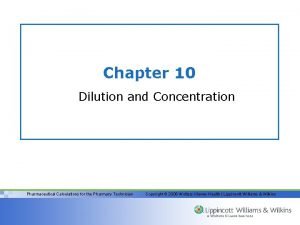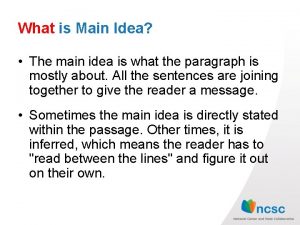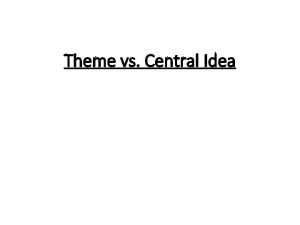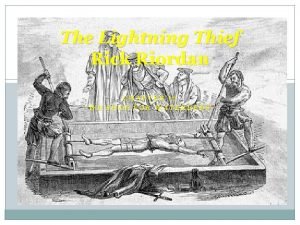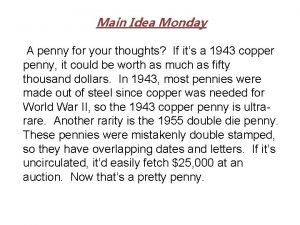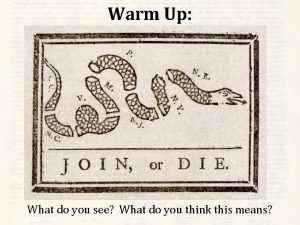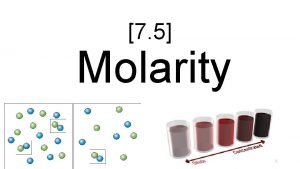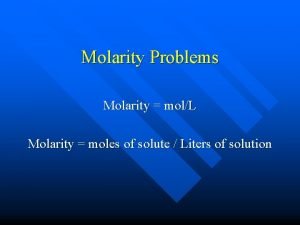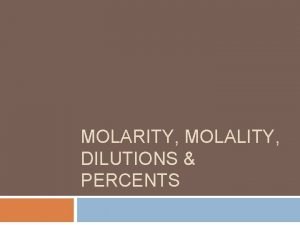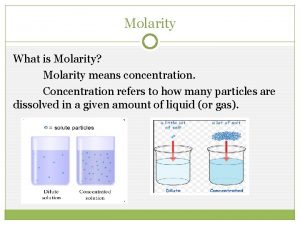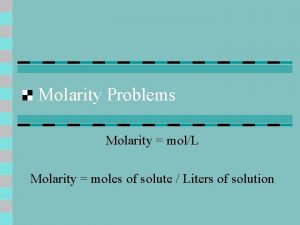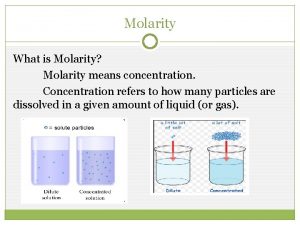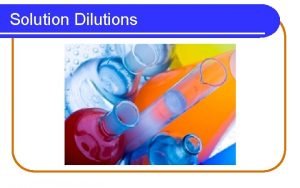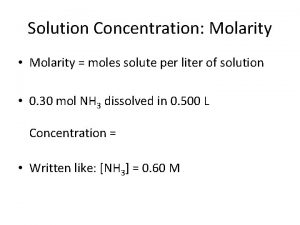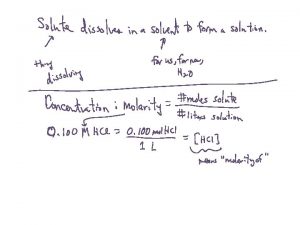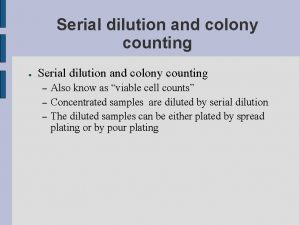Molarity Dilution and p H Main Idea Solution

































































![Calculating the p. H = - log [H+] (The [ ] means Molarity) Example: Calculating the p. H = - log [H+] (The [ ] means Molarity) Example:](https://slidetodoc.com/presentation_image/5fb420eafe7093e538a5ab20777b101d/image-66.jpg)



![More About Water Autoionization Kw = [H 3 O+] [OH-] = 1. 00 x More About Water Autoionization Kw = [H 3 O+] [OH-] = 1. 00 x](https://slidetodoc.com/presentation_image/5fb420eafe7093e538a5ab20777b101d/image-70.jpg)

![p. H [H+] [OH-] p. OH 72 p. H [H+] [OH-] p. OH 72](https://slidetodoc.com/presentation_image/5fb420eafe7093e538a5ab20777b101d/image-72.jpg)
![[H 3 O+], [OH-] and p. H What is the p. H of the [H 3 O+], [OH-] and p. H What is the p. H of the](https://slidetodoc.com/presentation_image/5fb420eafe7093e538a5ab20777b101d/image-73.jpg)
![[OH-] 4 -1 OH -p 10 0 1 x 0 +]. 1 [H -] [OH-] 4 -1 OH -p 10 0 1 x 0 +]. 1 [H -]](https://slidetodoc.com/presentation_image/5fb420eafe7093e538a5ab20777b101d/image-74.jpg)


![HOMEWORK 1) How much calcium hydroxide [Ca(OH)2], in grams, is needed to produce 1. HOMEWORK 1) How much calcium hydroxide [Ca(OH)2], in grams, is needed to produce 1.](https://slidetodoc.com/presentation_image/5fb420eafe7093e538a5ab20777b101d/image-77.jpg)

- Slides: 78

Molarity, Dilution, and p. H Main Idea: Solution concentrations are measured in molarity. Dilution is a useful technique for creating a new solution from a stock solution. p. H is a measure of the concentration of hydronium ions in a solution. 1

Properties of Aqueous Solutions • Solution- a homogeneous mixture of two or more substances. • Solute- a substance in a solution that is present in the smallest amount. • Solvent- a substance in a solution that is present in the largest amount. • In an aqueous solution, the solute is a liquid or solid and the solvent is always water.

Molarity Review • One of the most common units of solution concentration is molarity. • Molarity (M) is the number of moles of solute per liter of solution. • Molarity is also known as molar concentration, and the unit M is read as “molar. ” • A liter of solution containing 1 mol of solute is a 1 M solution, which is read as a “one-molar” solution. • A liter of solution containing 0. 1 mol of solute is a 0. 1 M solution. 3

Molarity Equation • To calculate a solution’s molarity, you must know the volume of the solution in liters and the amount of dissolved solute in moles. • Molarity (M) = moles of solute liters of solution 4

Molarity Example A 100. 5 -m. L intravenous (IV) solution contains 5. 10 g of glucose (C 6 H 12 O 6). What is the molarity of the solution? The molar mass of glucose is 180. 16 g/mol. SOLUTION: 1) Calculate the number of moles of C 6 H 12 O 6 by dividing mass over molar mass = 0. 0283 mol C 6 H 12 O 6 2) Convert the volume of H 2 O to liters by dividing volume by 1000 = 0. 1005 L 3) Solve for molarity by dividing moles by liters = 0. 282 M 5

Preparing Molar Solutions • Now that you know how to calculate the molarity of a solution, how would you prepare one in the laboratory? • STEP 1: Calculate the mass of the solute needed using the molarity definition and accounting for the desired concentration and volume. • STEP 2: The mass of the solute is measured on a balance. • STEP 3: The solute is placed in a volumetric flask of the correct volume. • STEP 4: Distilled water is added to the flask to bring the solution level up to the calibration mark. 6

http: //www. ltcconline. net/stevenson/2008 CHM 101 Fall/CHM 101 Lecture. Notes 20081022. htm 7

Properties of Aqueous Solutions • All solutes that dissolve in water fit into one of two categories: electrolyte or non-electrolyte. • Electrolyte- a substance that when dissolved in water conducts electricity • Non-electrolyte- a substance that when dissolved in water does not conduct electricity. • To have an electrolyte, ions must be present in water.

Electrolytic Properties of Aqueous Solutions • Na. Cl in water. – What happens? – Na. Cl(s) → Na+(aq) + Cl–(aq) – Completely dissociates

Strong vs. Weak Electrolytes • How do you know when an electrolyte is strong or weak? • Take a look at how HCl dissociates in water. – HCl(s) → H+(aq) + Cl–(aq)

Electrolytic Properties of Aqueous Solutions

Electrolytic Properties of Aqueous Solutions

Hydrated Ions

Electrolytic Properties of Aqueous Solutions • What about weak electrolytes? • What makes them weak? – Ionization of acetic acid • CH 3 COOH(aq) ↔ CH 3 COO–(aq) + H+(aq)

Electrolytic Solutions

Precipitation Reactions • Precipitation Reaction- a reaction that results in the formation of an insoluble product. • These reactions usually involve ionic compounds. • Formation of Pb. I 2: – Pb(NO 3)2(aq) + 2 KI(aq) → Pb. I 2(s) + 2 KNO 3(aq)

Preciptate

Precipitate

Precipitation Reactions • How do you know whether or not a precipitate will form when a compound is added to a solution? • By knowing the solubility of the solute! • Solubility- The maximum amount of solute that will dissolve in a given quantity of solvent at a specific temperature. • Three levels of solubility: Soluble, slightly soluble or insoluble.

Precipitation Reactions

Determining Solubility • Determine the solubility for the following: (1) Ag 2 SO 4 (2) Ca. CO 3 (3) Na 3 PO 4

Diluting Molar Solutions • In the laboratory, you might use concentrated solutions of standard molarities, called stock solutions. – For example, concentrated hydrochloric acid (HCl) is 12 M. • You can prepare a less-concentrated solution by diluting the stock solution with additional solvent. – Dilution is used when a specific concentration is needed and the starting material is already in the form of a solution (i. e. , acids). 22

Dilution of Solutions • When you want to dilute a solution, what happens to the number of moles present in the solution? – Do they increase? – Decrease? – Stay the same?

Dilution of Solutions

PROBLEM: You have 50. 0 m. L of 3. 0 M Na. OH and you want 0. 50 M Na. OH. What do you do? Add water to the 3. 0 M solution to lower its concentration to 0. 50 M Dilute the solution! 25

PROBLEM: You have 50. 0 m. L of 3. 0 M Na. OH and you want 0. 50 M Na. OH. What do you do? But how much water do we add? 26

PROBLEM: You have 50. 0 m. L of 3. 0 M Na. OH and you want 0. 50 M Na. OH. What do you do? How much water is added? The important point is that ---> moles of Na. OH in ORIGINAL solution = moles of Na. OH in FINAL solution 27

PROBLEM: You have 50. 0 m. L of 3. 0 M Na. OH and you want 0. 50 M Na. OH. What do you do? Amount of Na. OH in original solution = M • V = (3. 0 mol/L)(0. 050 L) = 0. 15 mol Na. OH Amount of Na. OH in final solution must also = 0. 15 mol Na. OH Volume of final solution = (0. 15 mol Na. OH) / (0. 50 M) = 0. 30 L or 300 m. L 28

PROBLEM: You have 50. 0 m. L of 3. 0 M Na. OH and you want 0. 50 M Na. OH. What do you do? Conclusion: add 250 m. L of water to 50. 0 m. L of 3. 0 M Na. OH to make 300 m. L of 0. 50 M Na. OH. 29

Preparing Solutions by Dilution A shortcut M 1 • V 1 = M 2 • V 2 Where M represents molarity and V represents volume. The 1 s are for the stock solution and the 2 s are for the solution you are trying to create. 30

What factors affect the rate of dissolving? 31

What factors affect the rate of dissolving? • Temperature • You can dissolve more into a warm liquid than you can into a cold liquid 32

What factors affect the rate of dissolving? • Temperature • You can dissolve more into a warm liquid than you can into a cold liquid • Surface area • Which dissolves faster, a cube of sugar or grains of sugar? Why? 33

What factors affect the rate of dissolving? • Temperature • You can dissolve more into a warm liquid than you can into a cold liquid • Surface area • Which dissolves faster, a cube of sugar or grains of sugar? Why? • Concentration • The more solute already dissolved in a solvent, the slower the rate of dissolving. 34

What factors affect the rate of dissolving? • Pressure • What affect would increasing pressure have on the rate of dissolving? Why? 35

What factors affect the rate of dissolving? • Pressure • What affect would increasing pressure have on the rate of dissolving? Why? • Mixing • Describe what happens when you mix a solution. 36

How do you get from this…

…to this?

Add an ionic compound!

Colligative Properties • Properties that depend only on the number of solute particles and not on their identity.

Some Colligative Properties are: • Vapor pressure lowering • Boiling point elevation • Freezing Point depression

Vapor Pressure

Vapor Pressure Lowering • The particles of solute are surrounded by and attracted to particles of solvent. • Now the solvent particles have less kinetic energy and tend less to escape into the space above the liquid. • So the vapor pressure is less.

Ionic vs Molecular Solutes • Ionic solutes produce two or more ion particles in solution. • They affect the colligative properties proportionately more than molecular solutes (that do not ionize). • The effect is proportional to the number of particles of the solute in the solution.

How many particles do each of the following give upon solvation? • Na. Cl • Ca. Cl 2 • Glucose

Freezing Point Depression

Example • Salt is added to melt ice by reducing the freezing point of water.

Boiling Point Elevation

Example • Addition of ethylene glycol C 2 H 6 O 2 (antifreeze) to car radiators.

Ready for a test soon? !? !? ! • It’s review time! • In this unit we studied SOLUTIONS! 50

Freezing Point Depression and Boiling Point Elevation • ∆Tb =mkb (for water kb=0. 51 o. C/m) • Freezing Point Depression o. C/m) • ∆Tf=mkf (for water k =1. 86 f • Note: m is the molality of the particles, so if the solute is ionic, multiply by the #of particles it dissociates to.

Which is more effective for lowering the freezing point of water? • Na. Cl or Ca. Cl 2

Example 1: • Find the new freezing point of 3 m Na. Cl in water.

Example 2: • Find the new boiling point of 3 m Na. Cl in water.

The p. H scale is a way of expressing the strength of acids and bases. Instead of using very small numbers, we just use the NEGATIVE power of 10 on the Molarity of the H+ (or OH-) ion. Under 7 = acid 7 = neutral Over 7 = base 55

Acid-Base Reactions • Acids- generally have a sour taste, change litmus from blue to red, can react with certain metals to produce gas, conduct electricity. • Bases- generally have a bitter taste, change litmus from red to blue, feel slippery, conduct electricity. • BrØnstead Acid- proton donor • BrØnstead Base- proton acceptor

Acid-Base Reactions • Acid or Base? – HCl(aq) + H 2 O(l) → H 3 O+(aq) + Cl–(aq) – NH 3(aq) + H 2 O(l) → NH 4+(aq) + OH–(aq)

Acid-Base Reactions • Look at the following compounds and decide whether they are a BrØnstead Acid or a BrØnstead Base. – HBr – NO 2– – HCO 3–

Arrhenius definition of acids and bases: Acids are compounds that give off H+ ions (also called hydronium ions, H 3 O+ ions, or simply “protons”) when you dissolve them in water. Bases are compounds that give off OH(hydroxide) ions when you dissolve them in water. 59

• Arrhenius acids almost always start with the letter “H” in their formulas – this is the source of the H+ ion that comes off when you dissolve the compound. Common examples include the following: • HNO 3(l) H+(aq) + NO 3(aq) • HCl • HBr • H 2 SO 4 • Arrhenius bases always have “OH” in their formulas, indicating the presence of the hydroxide ion. Common examples include: • Na. OH(s) Na+1(aq) + OH-1(aq) • KOH • Mg(OH)2 60

Acid-Base Reactions

p. H of Common Substances 62

p. H Value H+ Concentration Relative to Pure Water Example 0 10 000 battery acid 1 1 000 concentrated sulfuric acid 2 100 000 lemon juice, vinegar 3 10 000 orange juice, soda 4 1 000 tomato juice, acid rain 5 100 black coffee, bananas 6 10 urine, milk 7 1 pure water 8 0. 1 sea water, eggs 9 0. 01 baking soda 10 0. 001 Great Salt Lake, milk of magnesia 11 0. 000 1 ammonia solution 12 0. 000 01 soapy water 13 0. 000 001 bleach, oven cleaner 14 0. 000 1 liquid drain cleaner 63

Put the following substances in order, from lowest p. H to highest p. H: • • Drain Cleaner Water Vinegar Soap Orange Juice Baking Soda Battery Acid 64

Put the following substances in order, from lowest p. H to highest p. H: • • Battery Acid Vinegar Orange Juice Water Baking Soda Soap Drain Cleaner Lowest p. H (most Acidic) Highest p. H (most Basic) 65
![Calculating the p H log H The means Molarity Example Calculating the p. H = - log [H+] (The [ ] means Molarity) Example:](https://slidetodoc.com/presentation_image/5fb420eafe7093e538a5ab20777b101d/image-66.jpg)
Calculating the p. H = - log [H+] (The [ ] means Molarity) Example: If [H+] = 1 X 10 -10 p. H = - log 1 X 10 -10 p. H = - (- 10) p. H = 10 Example: If [H+] = 1. 8 X 10 -5 p. H = - log 1. 8 X 10 -5 p. H = - (- 4. 74) p. H = 4. 74 66

p. H calculations – Solving for H+ If the p. H of Coke is 3. 12, [H+] = ? ? ? Because p. H = - log [H+] then - p. H = log [H+] Take antilog (10 x) of both sides and get 10 -p. H = [H+] = 10 -3. 12 = 7. 6 x 10 -4 M *** to find antilog on your calculator, look for “Shift” or “ 2 nd function” and then the log button 67

p. H calculations – Solving for H+ • A solution has a p. H of 8. 5. What is the Molarity of hydrogen ions in the solution? p. H = - log [H+] 8. 5 = - log [H+] -8. 5 = log [H+] Antilog -8. 5 = antilog (log [H+]) 10 -8. 5 = [H+] 3. 16 X 10 -9 = [H+] 68

More About Water H 2 O can function as both an ACID and a BASE…. . water is AMPHOTERIC In pure water there can be AUTOIONIZATION Equilibrium constant for water = Kw Kw = [H 3 O+] [OH-] = 1. 00 x 10 -14 at 25 o. C
![More About Water Autoionization Kw H 3 O OH 1 00 x More About Water Autoionization Kw = [H 3 O+] [OH-] = 1. 00 x](https://slidetodoc.com/presentation_image/5fb420eafe7093e538a5ab20777b101d/image-70.jpg)
More About Water Autoionization Kw = [H 3 O+] [OH-] = 1. 00 x 10 -14 at 25 o. C In a neutral solution [H 3 O+] = [OH-] so Kw = [H 3 O+]2 = [OH-]2 and so [H 3 O+] = [OH-] = 1. 00 x 10 -7 M 70

p. OH • Since acids and bases are opposites, p. H and p. OH are opposites! • p. OH does not really exist, but it is useful for changing bases to p. H. • p. OH looks at the perspective of a base p. OH = - log [OH-] Since p. H and p. OH are on opposite ends, p. H + p. OH = 14 71
![p H H OH p OH 72 p. H [H+] [OH-] p. OH 72](https://slidetodoc.com/presentation_image/5fb420eafe7093e538a5ab20777b101d/image-72.jpg)
p. H [H+] [OH-] p. OH 72
![H 3 O OH and p H What is the p H of the [H 3 O+], [OH-] and p. H What is the p. H of the](https://slidetodoc.com/presentation_image/5fb420eafe7093e538a5ab20777b101d/image-73.jpg)
[H 3 O+], [OH-] and p. H What is the p. H of the 0. 0010 M Na. OH solution? [OH-] = 0. 0010 (or 1. 0 X 10 -3 M) p. OH = - log 0. 0010 p. OH = 3 p. H = 14 – 3 = 11 OR Kw = [H 3 O+] [OH-] [H 3 O+] = 1. 0 x 10 -11 M p. H = - log (1. 0 x 10 -11) = 11. 00 73
![OH 4 1 OH p 10 0 1 x 0 1 H [OH-] 4 -1 OH -p 10 0 1 x 0 +]. 1 [H -]](https://slidetodoc.com/presentation_image/5fb420eafe7093e538a5ab20777b101d/image-74.jpg)
[OH-] 4 -1 OH -p 10 0 1 x 0 +]. 1 [H -] [H+] 4 -1 H g[O -Lo 0 1 x - ] 0 1. OH [ p. OH +] g[H -Lo H -p 10 H O p 4 1 p. H H p 14 74

Oxidation Reduction Reactions • Oxidation Reaction- refers to the half-reaction that involves the loss of electrons. • Reduction Reaction- refers to the half-reaction that involves the gain of electrons. OILRIG • Oxidizing agent- the compound or ion in a redox reaction that donates electrons. • Reducing agent- the compound or ion in a redox reaction that accepts electrons.

Oxidation-Reduction Reactions
![HOMEWORK 1 How much calcium hydroxide CaOH2 in grams is needed to produce 1 HOMEWORK 1) How much calcium hydroxide [Ca(OH)2], in grams, is needed to produce 1.](https://slidetodoc.com/presentation_image/5fb420eafe7093e538a5ab20777b101d/image-77.jpg)
HOMEWORK 1) How much calcium hydroxide [Ca(OH)2], in grams, is needed to produce 1. 5 L of a 0. 25 M solution? 2) What volume of a 3. 00 M KI stock solution would you use to make 0. 300 L of a 1. 25 M KI solution? 3) How many m. L of a 5. 0 M H 2 SO 4 stock solution would you need to prepare 100. 0 m. L of 0. 25 M H 2 SO 4? 4) If 0. 50 L of 5. 00 M stock solution is diluted to make 2. 0 L of solution, how much HCl, in grams, is in the solution? 77

HOMEWORK 5) Calculate the p. H of solutions having the following ion concentrations at 298 K. a) [H+] = 1. 0 x 10 -2 M b) [H+] = 3. 0 x 10 -6 M 6) Calculate the p. H of a solution having [OH-] = 8. 2 x 10 -6 M. 7) Calculate p. H and p. OH for an aqueous solution containing 1. 0 x 10 -3 mol of HCl dissolved in 5. 0 L of solution. 8) Calculate the [H+] and [OH-] in a sample of seawater with a p. OH = 5. 60. 78
 Tell more about the main idea
Tell more about the main idea Serial dilution method
Serial dilution method Dilution and dilution factor microbiology
Dilution and dilution factor microbiology Molarity
Molarity It reveals the main or central idea of a paragraph
It reveals the main or central idea of a paragraph Controlling idea adalah
Controlling idea adalah What's the big idea
What's the big idea Example of irrelevant
Example of irrelevant What does dilution is the solution to pollution mean
What does dilution is the solution to pollution mean Which statement describes solute
Which statement describes solute How to find moles from molarity
How to find moles from molarity Molarity equation examples
Molarity equation examples Molarity
Molarity How to find molarity
How to find molarity Ideal solution and non ideal solution
Ideal solution and non ideal solution What are topic sentences
What are topic sentences Main idea vs theme
Main idea vs theme Which statement presents the main idea of the text?
Which statement presents the main idea of the text? Penguin chick main idea and details
Penguin chick main idea and details Major detail and minor detail
Major detail and minor detail Major supporting detail
Major supporting detail Main idea and supporting details example paragraphs
Main idea and supporting details example paragraphs Main idea and supporting details jeopardy
Main idea and supporting details jeopardy Main idea and supporting details examples
Main idea and supporting details examples Body paragraph
Body paragraph Topic sentence example
Topic sentence example After realizing his own mistake the grasshopper felt
After realizing his own mistake the grasshopper felt Topic main idea and supporting details examples
Topic main idea and supporting details examples Major details vs minor details
Major details vs minor details Outline main idea and supporting details
Outline main idea and supporting details Theme vs topic
Theme vs topic Stated and implied main idea exercises
Stated and implied main idea exercises Major and minor details quiz
Major and minor details quiz Why is the spider and the wasp an expository essay
Why is the spider and the wasp an expository essay Main idea and supporting details example
Main idea and supporting details example Example of topic sentence and supporting details
Example of topic sentence and supporting details Minor supporting details examples
Minor supporting details examples Effective paragraph
Effective paragraph Making an outline
Making an outline Main idea and supporting details
Main idea and supporting details Main idea and details
Main idea and details Who wrote hope despair and memory
Who wrote hope despair and memory Homiletical idea
Homiletical idea Kepentingan penanda organisasi
Kepentingan penanda organisasi Pharmacy dilution calculations pdf
Pharmacy dilution calculations pdf 2 types of main idea
2 types of main idea Main ideaa
Main ideaa Title can be
Title can be Central idea definition
Central idea definition Theme from the giver
Theme from the giver Percy jackson the lightning thief chapter 17
Percy jackson the lightning thief chapter 17 Anne frank diary
Anne frank diary You may think it's bad to forget your homework
You may think it's bad to forget your homework Topic of the passage
Topic of the passage Chapter 9 section 2 manifest destiny answer key
Chapter 9 section 2 manifest destiny answer key Big paragraph
Big paragraph Whats main idea
Whats main idea Short story with main idea
Short story with main idea Main idea flocabulary
Main idea flocabulary A penny for your thoughts main idea
A penny for your thoughts main idea Main idea mini lesson
Main idea mini lesson Implied main idea
Implied main idea Examples of implied main idea
Examples of implied main idea Implied main idea
Implied main idea Implied main idea definition
Implied main idea definition Unstated main idea
Unstated main idea Main idea formula
Main idea formula Main idea of enlightenment
Main idea of enlightenment Main idea formula
Main idea formula Theme in charlotte's web
Theme in charlotte's web Main idea vs theme
Main idea vs theme What is the main idea of the cartoon above?
What is the main idea of the cartoon above? Main idea hand
Main idea hand What is the main idea of psychology
What is the main idea of psychology What is the main idea of give me liberty or give me death
What is the main idea of give me liberty or give me death What is the main idea of the cartoon?
What is the main idea of the cartoon? Main idea
Main idea What was this
What was this Tuck everlasting chapter 24 summary
Tuck everlasting chapter 24 summary

